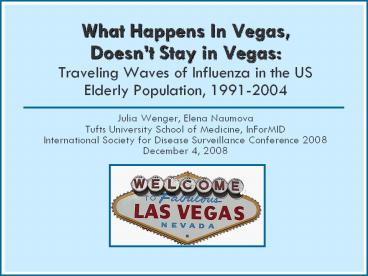What Happens In Vegas, Doesn PowerPoint PPT Presentation
1 / 26
Title: What Happens In Vegas, Doesn
1
What Happens In Vegas, Doesnt Stay in
VegasTraveling Waves of Influenza in the US
Elderly Population, 1991-2004
- Julia Wenger, Elena Naumova
- Tufts University School of Medicine, InForMID
- International Society for Disease Surveillance
Conference 2008 - December 4, 2008
2
Study Objectives
- Goals
- To examine trends of traveling waves of influenza
in the US elderly population - To assess seasonal variation across individual
influenza seasons on a state-by-state basis - To examine the relationship between peak timing
and intensity of influenza seasons
3
Data Sources / Geographic-Temporal Factors
- 248,889 de-identified hospitalizations for
elderly (aged 65 and over) from Centers for
Medicare and Medicaid Services with influenza
(ICD-9CM, 487) listed in any diagnosis (of 10)
between 1991 and 2004 - Covers 98 of the population aged 65 years and
older1 - Census 2000 for population estimates and rate
calculations - Influenza seasons defined as July 1st June 30th
of the subsequent calendar year - Modeling for the 48 contiguous states and
Washington, DC
1Naumova, E.N., Castronovo, D., Cohen, S.A.,
Kosheleva, A., Naumov, Y.N., Gorski, J. The
Spatiotemporal Dynamics of Influenza
Hospitalizations in the United States Elderly. In
preparation.
4
Annual Harmonic Regression (AHR)
- Annual Harmonic Regression is a modified
Serfling-type regression model to characterize
variation between epidemic curves, - where i indicates individual seasons
Definitions Peak week The week at which disease
incidence was highest Absolute Intensity
Difference between maximum and minimum seasonal
incidence
- Advantages
- Captures complex non-linear trends over a long
time frame - Captures characteristics of individual seasons
- Seasonal characteristics can be further examined
for inter-season heterogeneity and intra-season
correlations
5
Weekly Time Series 1991-2004
Across 13 seasons, peak timing is similar (late
December-late January). Disguises seasonal
differences and state-by-state synchrony.
6
Weekly Time Series by Season 1991-2004
Looking at average peak timing for each season,
peak timing ranges from the 23rd 32nd
week. Important to further investigate seasonal
variations and then state-level differences.
7
Ordered peak week of influenza hospitalizations
by state 1991-2004
- When examining average across 13 seasons, Nevada
is first state to experience peak week of
influenza season (week 26), Maine is the last - Overall, the peak timing of an influenza season
averaged 4 weeks across US - West to east movement was dominant
- However, the overall pattern does not fully
determine synchronization of individual seasons
8
1991-1992
9
1992-1993
10
1993-1994
11
1994-1995
12
1995-1996
13
1996-1997
14
1997-1998
15
1998-1999
16
1999-2000
17
2000-2001
18
2001-2002
19
2002-2003
20
2003-2004
21
Peak Week Intensity 1991-2004
- The earlier the peak in an influenza season,
the more intense the season is experienced
22
Peak Week Absolute Intensity Inter-State
Variability
Low Intensity States
High Intensity States
23
Discussion / Implications
- Why Nevada?
- High transient population in Nevada leading to
viral illness.1 - Multicity trip patterns indicate that Las Vegas
is popular destination for international travels
on multicity trips both to Los Angeles and then
to New York City.2 - Why the Dakotas?
- High proportion of elderly population,
susceptibility due to immunosenesence. - High dependency ratio in both states (proportion
of elderly 65 to those of working class age)3 - Individual influenza seasons show synchrony
- Inverse relationship between peak timing and
intensity the earlier the peak, the more disease - Surveillance should focus not just on timing (who
gets hit first) but on intensity (who gets hit
hardest)
1Robinson, L.L., Smith, A.H. Final Report and
Recommendations to the Nevada State Health
Divisions. 2004. 2Hwang, Y.H., Gretzel, U.,
Fesenmaier, D.R. Multicity Trip Patterns
Tourists to the United States. Annals of Tourism
Research 2006331057-1078. 3Data derived from
Census 2000.
24
Acknowledgements
- Funding Source
- NIH-NIAID, Grant HHSN26620050032C
- NIH-NIAID, Grant U19AI062627
- Data Source
- Centers for Medicare and Medicaid Services (CMS)
- Other support
- Members of the Tufts InForMID research group
Steven Cohen, MPH, PhD Ken Chui, MS, MPH
Jyotsna Jagai, MS, MPH
25
Thank You!
Julia Wenger Julia.Wenger_at_tufts.edu http//www.tuf
ts.edu/med/informid/index.html
26
Circulating Strain
Circulating virus strain based on WHO Weekly
Epidemiologic Reports recommended vaccine strain
and MMWR reports on seasonal influenza activity.

